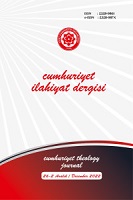İbn Teymiyye’den Önce Kur’ân’ın Kur’ân’la Tefsirini Bir Metot Olarak Öneren Âlim: Ebû Bekir İbnü’l-Arabî
The Scholar who Suggested the Exegesis of the Qur'ān with the Qur'ān as a Method before Ibn Taymiyya: Abū Bakr Ibn al-ʿArabī
Author(s): Fatma YalnızSubject(s): History of Islam, History of Religion, Qur’anic studies, Psychology of Religion
Published by: Cumhuriyet Üniversitesi İlahyat Fakültesi
Keywords: Exegesis (Tafsīr); Tafsīr of the Qur'ān with the Qur'ān; Abū Bakr Ibn al-ʿArabī; Ibn Taymiyya;
Summary/Abstract: There is a prevailing opinion in the literature that the first person to mention the interpretation of the Qur'ān with the Qur'ān as a method is Ibn Taymiyya (728/1328). Ibn Taymiyya puts this method at the forefront in the hierarchy of evidence he put forward in Muqaddima fī usūl al-tafsīr (Introduction to the Methodology of Exegesis). However, Abū Bakr ibn al-ʿArabī (d. 543/1148), who lived two centuries before him, also refers to the same method in the first place among the tafsīr methods he suggested. In this direction, in this article, Ibnu'l-Arabi's Qānūn al-Ta'wīl and Ibn Taymiyya's Muqaddima are the evidence that the interpretation of the Qur'ān with the Qur'ān is in the first place. Since they create a hierarchy of tafsīr, they are presented as works that try to determine a method for tafsīr. Subsequently, Ibn Taymiyya's presentation of the Qur'ān's interpretation with the Qur'ān as the most correct way of interpretation and the subsequent ordering of the hierarchy of evidence as a whole are shown in detail. Ibn Taymiyya states that if there is no interpretation of the Qur'ān with the Qur'ān in the hierarchy of evidence, which he describes as the best way of tafsīr, it is necessary to refer to the narrations of the companions and the narrations of the consensus of the tābiʿūn (successors of the companions), respectively, after the Sunnah. Ibn Taymiyyah states that it is necessary to resort to ijtihād in the parts of the subject in dispute, and states that legitimate ijtihādi tafsīr can be done through language and shari'ah - without centering any ideology. Ibn 'Arabi, on the other hand, created a two-stage hierarchy of evidence in order to correct the accuracy of the interpretations. In the first stage, Ibn al-Arabi emphasized that if the interpretation was made by using the interpretation of the Qur'ān with the Qur'ān, that interpretation would be accepted as correct without the need for any other evidence. However, if the verse is not provided with evidence while interpreting, the sunnah will be applied. The author, who went to the second stage in order to provide the ta'wīl made without showing the verse and sunnah evidence. In order to evaluate the interpretation made at this stage, he considered it necessary to verify with language and sharia evidence. Although there is a similarity in the order of the hierarchies of evidence between Ibn Taymiyya and Ibn al-Arabi, Ibn al-Arabi explained a detailed path to be followed in addition to this hierarchy. Then, in our study, we focused on the reasons why the authors put the interpretation of the Qur'ān with the Qur'ān in the first place. In this direction, various signs such as Ibn al-Arabi's foregrounding the apparent in Qānūn al-Ta'wīl, mentioning the Qur'ān in the first place in the explanation of various ambiguities in the Qur'ān, and preferring the verse to the news are some of the signs that he saw it necessary. This gives us clues about the background of his putting the evidence first. In addition, as another sign of Ibn al-Arabi's prioritization of the Qur'ān, the fact that the Andalusia region was mostly in the Maliki sect in the time period he lived and its apparent precedence can be shown. In addition, it can be stated that the fact that the author was inspired by the Muādh hadith, which is accepted as the basis for the formula of qiyas in the fiqh method, as he is a Maliki jurist, may have been effective in placing the Qur'ān and tafsīr first in the hierarchy of evidence he suggested for tafsīr. It can be said that Ibn Taymiyya's advice of a hierarchy of evidence that puts the Qur'ān in the first place has the aim of eliminating the creed, political and intellectual differences and ensuring the unity of the Muslims. Finally, in our study, the problems that arise due to the fact that Ibn al-Arabi and Ibn Taymiyya put the interpretation of the Qur'ān with the Qur'ān in the first place in their works are shed light on. The first problem is whether the way in which the relevant authors put the Qur'ān and its interpretation first in the classical period, in which they lived, is different from the followers of the Ahl al- Qur'ān in the modern period. When the problem is examined, the fact that the scholars we took in the center mentioned evidences in addition to the interpretation of the Qur'ān with the Qur'ān gives us a clue that the classical period followed a more holistic path in the hierarchy of evidence. Another problem is whether the interpretation of the Qur'ān with the Qur'ān, which is included in the hierarchy of evidence presented by the relevant authors, is based on riwaya or diraya. It can be said that Ibn al-Arabi is closer to dirāya (sagacity) and Ibn Taymiyyah to riwāya (narrative) tafsīr. As a result, although there are differences between two scholars regarding the application of the relevant method, Ibn al-Arabi's mention of this method two centuries before Ibn Taymiyya is that the interpretation of the Qur'ān with the Qur'ān is a method. It is important that this will change the general acceptance about the date of its proposal.
Journal: Cumhuriyet İlahiyat Dergisi
- Issue Year: 26/2022
- Issue No: 2
- Page Range: 863-880
- Page Count: 18
- Language: Turkish

